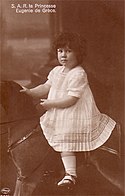Prinsesse Eugénie af Grækenland
| Prinsesse Eugénie af Grækenland | |
|---|---|
 Prinsesse Eugénie som barn. | |
| Prinsesse af Grækenland og Danmark | |
| Ægtefæller | Fyrst Dominik Rainer Radziwill (g. 1938–46) Raymundo della Torre e Tasso (g. 1949–65) |
| Børn |
|
| Hus | Huset Glücksborg |
| Far | Prins Georg af Grækenland |
| Mor | Marie Bonaparte |
| Født | 10. februar 1910 Paris, Frankrig |
| Død | 13. februar 1989 (79 år) Genève, Schweiz |
Prinsesse Eugénie af Grækenland og Danmark (græsk: Πριγκίπισσα Ευγενία της Ελλάδας και Δανίας; 10. februar 1910–13. februar 1989) var en græsk prinsesse, der var datter af Prins Georg af Grækenland og Marie Bonaparte. Hendes far var den næstældste søn af Kong Georg 1. af Grækenland og Dronning Olga. Hun var gift med Fyrst Dominik Rainer Radziwill fra 1938 til 1946 og Prins Raymundo della Torre e Tasso, 2. Hertug af Castel Duino fra 1949 til 1965.
Referencer
 Der er for få eller ingen kildehenvisninger i denne artikel, hvilket er et problem. Du kan hjælpe ved at angive troværdige kilder til de påstande, som fremføres i artiklen.
Der er for få eller ingen kildehenvisninger i denne artikel, hvilket er et problem. Du kan hjælpe ved at angive troværdige kilder til de påstande, som fremføres i artiklen.
Litteratur
- Bramsen, Bo (1992). Huset Glücksborg. Europas svigerfader og hans efterslægt (2. udgave). København: Forlaget Forum. ISBN 87-553-1843-6.
Eksterne links
| Artiklen om Prinsesse Eugénie af Grækenland kan blive bedre, hvis der indsættes et (bedre) billede. Du kan hjælpe ved at afsøge Wikimedia Commons for et passende billede eller uploade et godt billede til Wikimedia Commons iht. de tilladte licenser og indsætte det i artiklen. |
| Spire Denne artikel om en kongelig eller fyrstelig person er en spire som bør udbygges. Du er velkommen til at hjælpe Wikipedia ved at udvide den. |
Medier brugt på denne side
coroa de Santo Eduardo modificada para userbox (Wikipedia:Userbox/Monarquia)
Coat of arms of the Kingdom of Greece in 1936–1973
- Royal Coat of Arms of Greece under the Glücksburg dynasty, created after the restoration of King George II to the throne in 1935, to the exile of King Constantine II in 1967 and finally until the abolition of the monarchy in 1973.
- The Escutcheon features the white cross on a dark blue field of Greece. The Inescutcheon features the Arms of the Greek line of the House of Schleswig-Holstein-Sonderburg-Glücksburg. The shield is then topped with a golden Royal Crown.
- It features an escutcheon divided by the red and white cross of the Order of the Danneborg, the first quarter features the arms of Denmark (three crowned blue lions and nine hearts in yellow field). The second of Schleswig (two blue lions passant in yellow field). The third divided into four; the chief features the three royal crowns in blue field of the Kalmar Union, the second half with a crowned stockfish on red field of Iceland and the last half divided between the ram of the Faroe Islands and a polar bear of Greenland, both on blue fields. The fourth quarter is divided between two halves, the chief depicts a yellow field with a blue lion passant over nine red hearts of the King of the Goths, the lower half depicts a crowned golden lindorm on a red field of the King of the Wends.
- Upon it is another inescutcheon in red, divided into four quarters: the first a a silver nettle leaf of Holstein, the second the a swan with a golden crown of Stormarn, the third a knight dressed in golden armor on a silver horse of Dithmarschen and the fourth of a golden horse's head of Lauenburg.
- Upon it is another inescutcheon divided the first features the red and yellow bars of Oldenburg, the second a golden cross on a blue field of Delmenhorst.
- The escutcheon rests on a golden pedestal and supported by two human figures representing the Greek mythological hero Herakles (Heracles), holding a wooden club and wearing the skin of the Nemean lion.
- The escutcheon is surrounded by the ribbon and cross of the Order of the Redeemer, the cross depicts Christ Pantocrator, surrounded by the order's motto:"Η ΔΕΞΙΑ ΣΟΥ ΧΕΙΡ, ΚΥΡΙΕ, ΔΕΔΟΞΑΣΤΑΙ ΕΝ ΙΣΧΥΙ" or "Thy right hand, O Lord, is become glorious in power" from Exodus, 15:6.
- The motto of the Coat of arms and of the dynasty, depicted on a golden ribbon below the pedestal reads: "Ἰσχύς μου ἡ ἀγάπη τοῦ λαοῦ" or "The people's love, my strength"
- The coat of arms is then surrounded by a dark blue mantle and topped with another royal crown.





